IT Virtualisation Report: Implementation and Management Overview
VerifiedAdded on 2019/12/28
|15
|3169
|137
Report
AI Summary
This report provides a comprehensive overview of IT virtualisation, focusing on its application and impact for Company A. It begins with an introduction to virtualisation, explaining its benefits and potential. The report then delves into the commercial impact of virtual infrastructure, highlighting cost savings, technological advancements, and improved support and redundancy. It identifies Company A's specific needs, including server management, storage, and maximizing uptime. The core of the report outlines the design of a new virtual infrastructure, including the selection of virtualisation software, hardware requirements, and a detailed design process. Furthermore, the report covers the implementation and management of the virtualisation deployment, detailing the steps involved in building, configuring, securing, monitoring, and maintaining the virtual environment. Specific examples of virtual machine configurations, including processor, memory, and network settings, are provided for both VMware and Microsoft Hyper-V servers, offering a practical guide to implementation. The report concludes with a discussion of ongoing maintenance and monitoring, emphasizing the importance of adapting to evolving needs and technologies.
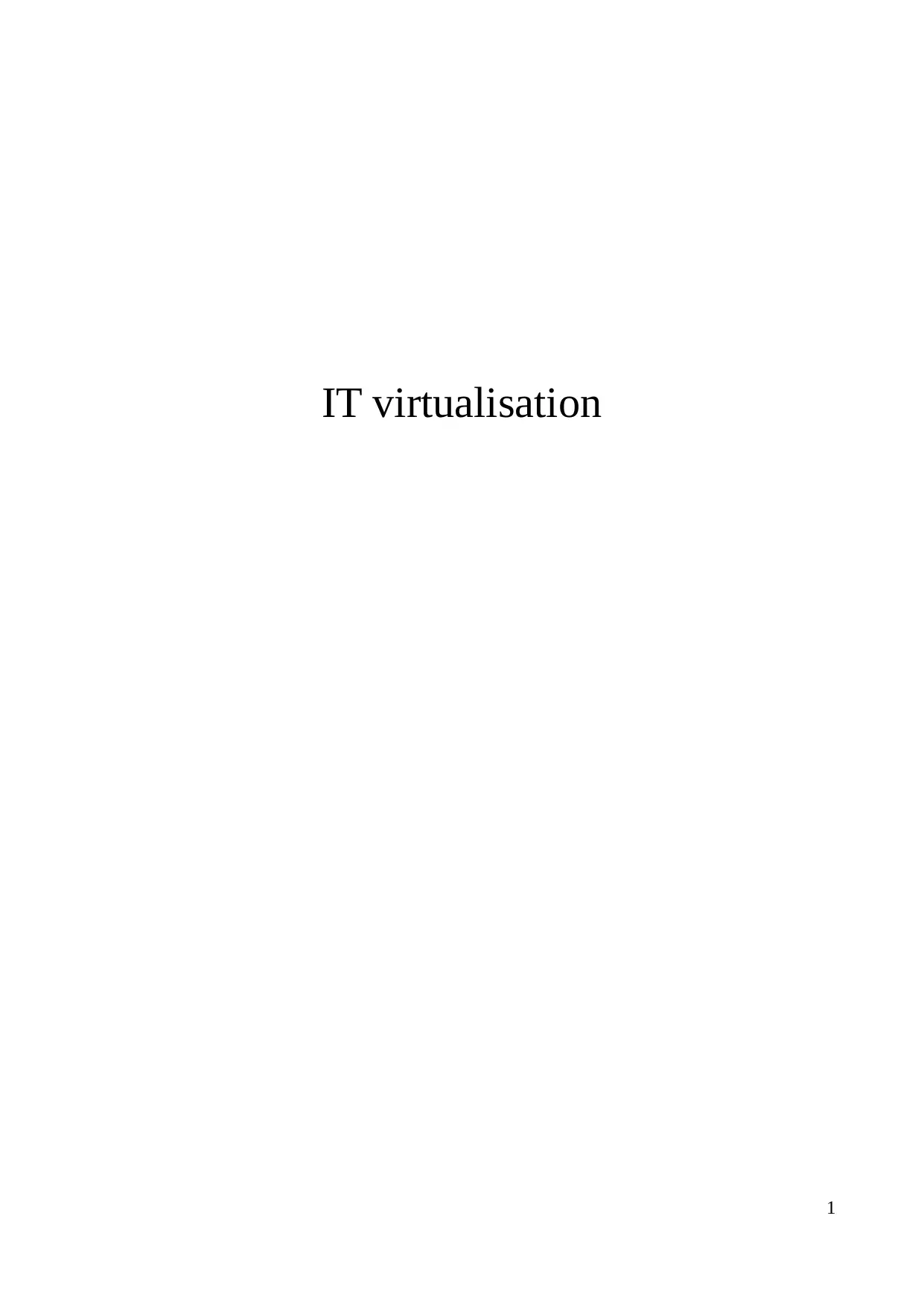
IT virtualisation
1
1
Paraphrase This Document
Need a fresh take? Get an instant paraphrase of this document with our AI Paraphraser

Table of Contents
INTRODUCTION................................................................................................................................4
TASK 1.................................................................................................................................................4
1.1 Commercial impact and potential of virtual infrastructure.......................................................4
TASK 3.................................................................................................................................................7
Management of virtualisation environment.....................................................................................9
CONCLUSION..................................................................................................................................10
References...........................................................................................................................................11
2
INTRODUCTION................................................................................................................................4
TASK 1.................................................................................................................................................4
1.1 Commercial impact and potential of virtual infrastructure.......................................................4
TASK 3.................................................................................................................................................7
Management of virtualisation environment.....................................................................................9
CONCLUSION..................................................................................................................................10
References...........................................................................................................................................11
2

3
⊘ This is a preview!⊘
Do you want full access?
Subscribe today to unlock all pages.

Trusted by 1+ million students worldwide

4
Paraphrase This Document
Need a fresh take? Get an instant paraphrase of this document with our AI Paraphraser

5

6
⊘ This is a preview!⊘
Do you want full access?
Subscribe today to unlock all pages.

Trusted by 1+ million students worldwide
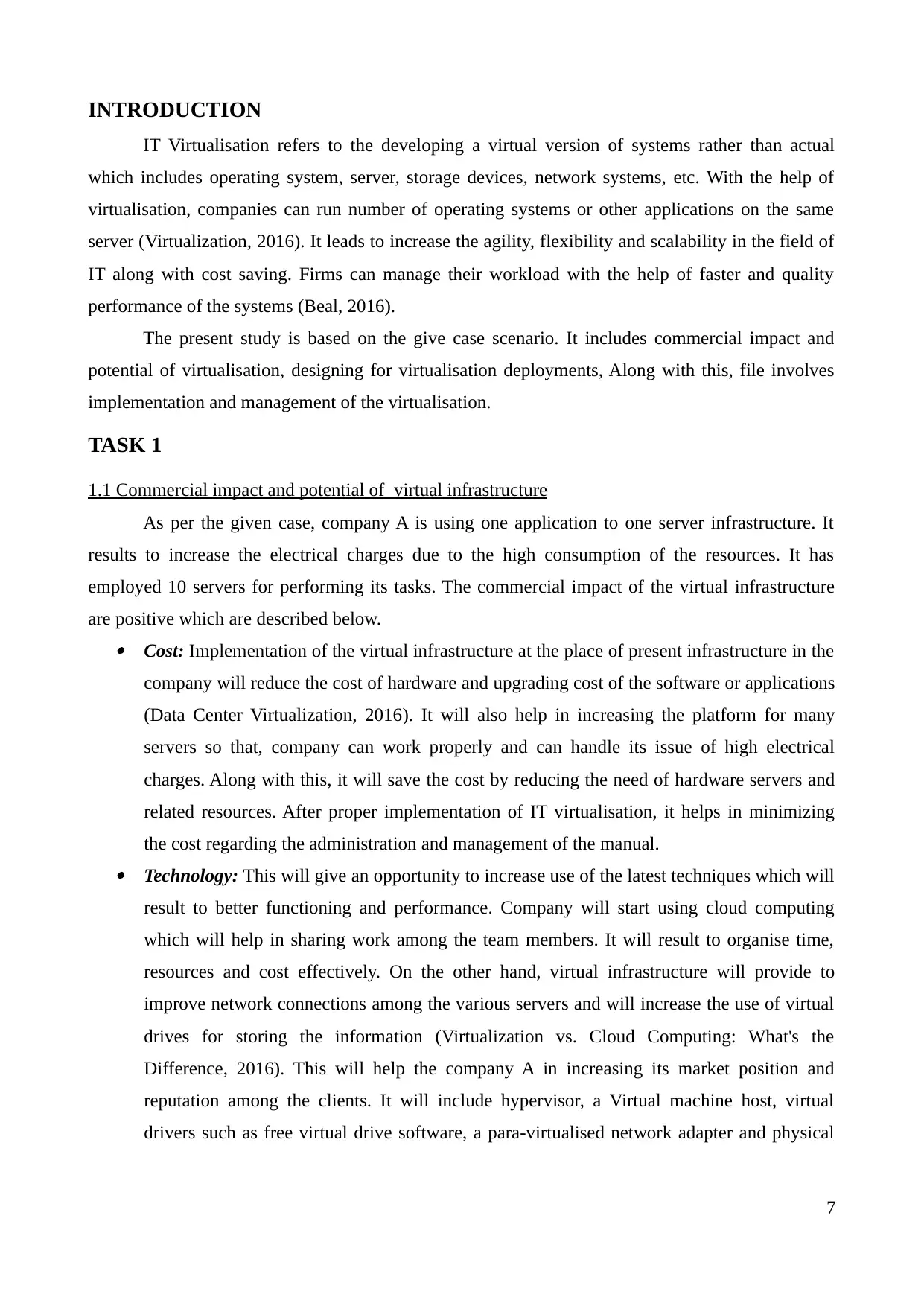
INTRODUCTION
IT Virtualisation refers to the developing a virtual version of systems rather than actual
which includes operating system, server, storage devices, network systems, etc. With the help of
virtualisation, companies can run number of operating systems or other applications on the same
server (Virtualization, 2016). It leads to increase the agility, flexibility and scalability in the field of
IT along with cost saving. Firms can manage their workload with the help of faster and quality
performance of the systems (Beal, 2016).
The present study is based on the give case scenario. It includes commercial impact and
potential of virtualisation, designing for virtualisation deployments, Along with this, file involves
implementation and management of the virtualisation.
TASK 1
1.1 Commercial impact and potential of virtual infrastructure
As per the given case, company A is using one application to one server infrastructure. It
results to increase the electrical charges due to the high consumption of the resources. It has
employed 10 servers for performing its tasks. The commercial impact of the virtual infrastructure
are positive which are described below. Cost: Implementation of the virtual infrastructure at the place of present infrastructure in the
company will reduce the cost of hardware and upgrading cost of the software or applications
(Data Center Virtualization, 2016). It will also help in increasing the platform for many
servers so that, company can work properly and can handle its issue of high electrical
charges. Along with this, it will save the cost by reducing the need of hardware servers and
related resources. After proper implementation of IT virtualisation, it helps in minimizing
the cost regarding the administration and management of the manual. Technology: This will give an opportunity to increase use of the latest techniques which will
result to better functioning and performance. Company will start using cloud computing
which will help in sharing work among the team members. It will result to organise time,
resources and cost effectively. On the other hand, virtual infrastructure will provide to
improve network connections among the various servers and will increase the use of virtual
drives for storing the information (Virtualization vs. Cloud Computing: What's the
Difference, 2016). This will help the company A in increasing its market position and
reputation among the clients. It will include hypervisor, a Virtual machine host, virtual
drivers such as free virtual drive software, a para-virtualised network adapter and physical
7
IT Virtualisation refers to the developing a virtual version of systems rather than actual
which includes operating system, server, storage devices, network systems, etc. With the help of
virtualisation, companies can run number of operating systems or other applications on the same
server (Virtualization, 2016). It leads to increase the agility, flexibility and scalability in the field of
IT along with cost saving. Firms can manage their workload with the help of faster and quality
performance of the systems (Beal, 2016).
The present study is based on the give case scenario. It includes commercial impact and
potential of virtualisation, designing for virtualisation deployments, Along with this, file involves
implementation and management of the virtualisation.
TASK 1
1.1 Commercial impact and potential of virtual infrastructure
As per the given case, company A is using one application to one server infrastructure. It
results to increase the electrical charges due to the high consumption of the resources. It has
employed 10 servers for performing its tasks. The commercial impact of the virtual infrastructure
are positive which are described below. Cost: Implementation of the virtual infrastructure at the place of present infrastructure in the
company will reduce the cost of hardware and upgrading cost of the software or applications
(Data Center Virtualization, 2016). It will also help in increasing the platform for many
servers so that, company can work properly and can handle its issue of high electrical
charges. Along with this, it will save the cost by reducing the need of hardware servers and
related resources. After proper implementation of IT virtualisation, it helps in minimizing
the cost regarding the administration and management of the manual. Technology: This will give an opportunity to increase use of the latest techniques which will
result to better functioning and performance. Company will start using cloud computing
which will help in sharing work among the team members. It will result to organise time,
resources and cost effectively. On the other hand, virtual infrastructure will provide to
improve network connections among the various servers and will increase the use of virtual
drives for storing the information (Virtualization vs. Cloud Computing: What's the
Difference, 2016). This will help the company A in increasing its market position and
reputation among the clients. It will include hypervisor, a Virtual machine host, virtual
drivers such as free virtual drive software, a para-virtualised network adapter and physical
7
Paraphrase This Document
Need a fresh take? Get an instant paraphrase of this document with our AI Paraphraser
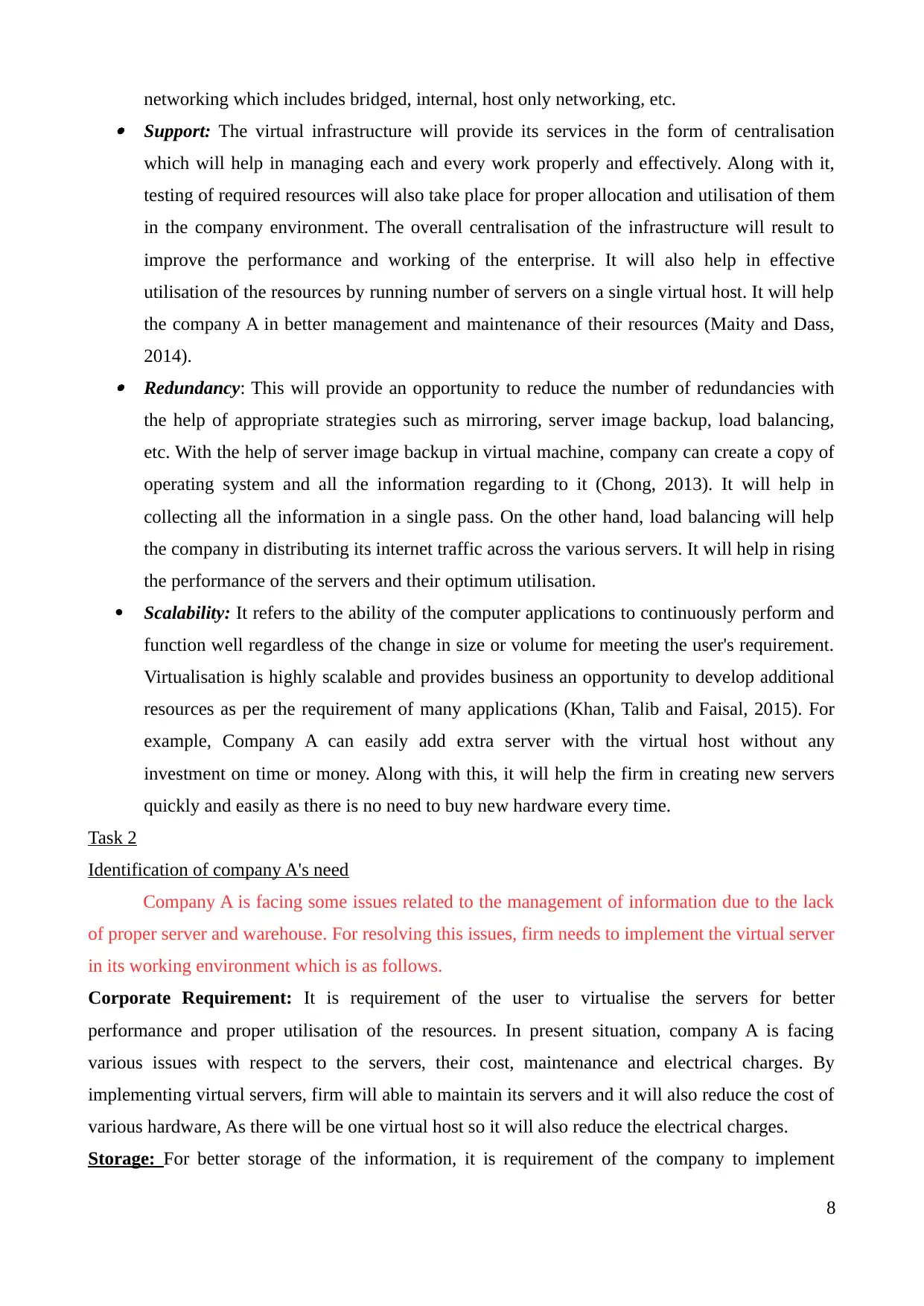
networking which includes bridged, internal, host only networking, etc. Support: The virtual infrastructure will provide its services in the form of centralisation
which will help in managing each and every work properly and effectively. Along with it,
testing of required resources will also take place for proper allocation and utilisation of them
in the company environment. The overall centralisation of the infrastructure will result to
improve the performance and working of the enterprise. It will also help in effective
utilisation of the resources by running number of servers on a single virtual host. It will help
the company A in better management and maintenance of their resources (Maity and Dass,
2014). Redundancy: This will provide an opportunity to reduce the number of redundancies with
the help of appropriate strategies such as mirroring, server image backup, load balancing,
etc. With the help of server image backup in virtual machine, company can create a copy of
operating system and all the information regarding to it (Chong, 2013). It will help in
collecting all the information in a single pass. On the other hand, load balancing will help
the company in distributing its internet traffic across the various servers. It will help in rising
the performance of the servers and their optimum utilisation.
Scalability: It refers to the ability of the computer applications to continuously perform and
function well regardless of the change in size or volume for meeting the user's requirement.
Virtualisation is highly scalable and provides business an opportunity to develop additional
resources as per the requirement of many applications (Khan, Talib and Faisal, 2015). For
example, Company A can easily add extra server with the virtual host without any
investment on time or money. Along with this, it will help the firm in creating new servers
quickly and easily as there is no need to buy new hardware every time.
Task 2
Identification of company A's need
Company A is facing some issues related to the management of information due to the lack
of proper server and warehouse. For resolving this issues, firm needs to implement the virtual server
in its working environment which is as follows.
Corporate Requirement: It is requirement of the user to virtualise the servers for better
performance and proper utilisation of the resources. In present situation, company A is facing
various issues with respect to the servers, their cost, maintenance and electrical charges. By
implementing virtual servers, firm will able to maintain its servers and it will also reduce the cost of
various hardware, As there will be one virtual host so it will also reduce the electrical charges.
Storage: For better storage of the information, it is requirement of the company to implement
8
which will help in managing each and every work properly and effectively. Along with it,
testing of required resources will also take place for proper allocation and utilisation of them
in the company environment. The overall centralisation of the infrastructure will result to
improve the performance and working of the enterprise. It will also help in effective
utilisation of the resources by running number of servers on a single virtual host. It will help
the company A in better management and maintenance of their resources (Maity and Dass,
2014). Redundancy: This will provide an opportunity to reduce the number of redundancies with
the help of appropriate strategies such as mirroring, server image backup, load balancing,
etc. With the help of server image backup in virtual machine, company can create a copy of
operating system and all the information regarding to it (Chong, 2013). It will help in
collecting all the information in a single pass. On the other hand, load balancing will help
the company in distributing its internet traffic across the various servers. It will help in rising
the performance of the servers and their optimum utilisation.
Scalability: It refers to the ability of the computer applications to continuously perform and
function well regardless of the change in size or volume for meeting the user's requirement.
Virtualisation is highly scalable and provides business an opportunity to develop additional
resources as per the requirement of many applications (Khan, Talib and Faisal, 2015). For
example, Company A can easily add extra server with the virtual host without any
investment on time or money. Along with this, it will help the firm in creating new servers
quickly and easily as there is no need to buy new hardware every time.
Task 2
Identification of company A's need
Company A is facing some issues related to the management of information due to the lack
of proper server and warehouse. For resolving this issues, firm needs to implement the virtual server
in its working environment which is as follows.
Corporate Requirement: It is requirement of the user to virtualise the servers for better
performance and proper utilisation of the resources. In present situation, company A is facing
various issues with respect to the servers, their cost, maintenance and electrical charges. By
implementing virtual servers, firm will able to maintain its servers and it will also reduce the cost of
various hardware, As there will be one virtual host so it will also reduce the electrical charges.
Storage: For better storage of the information, it is requirement of the company to implement
8
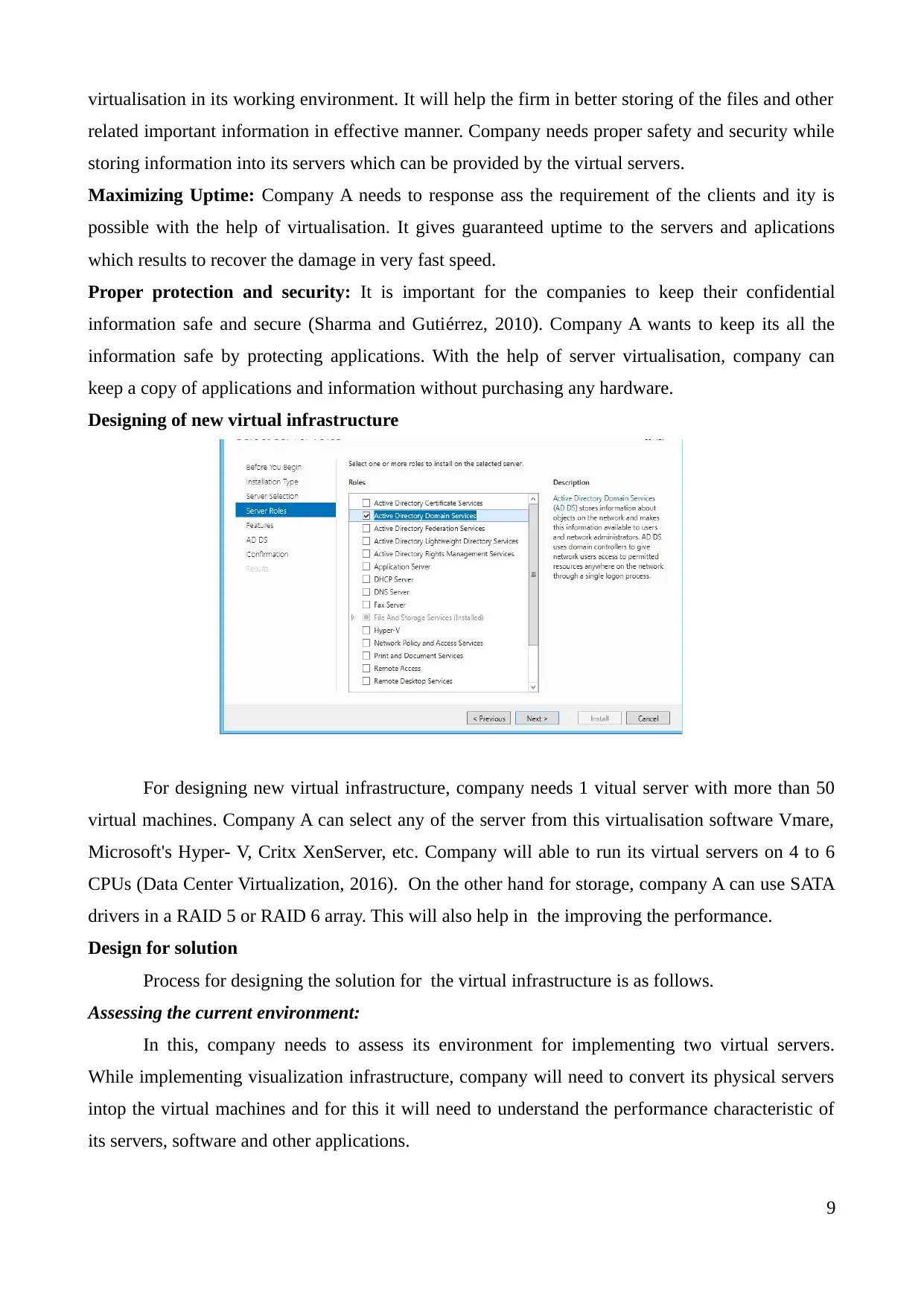
virtualisation in its working environment. It will help the firm in better storing of the files and other
related important information in effective manner. Company needs proper safety and security while
storing information into its servers which can be provided by the virtual servers.
Maximizing Uptime: Company A needs to response ass the requirement of the clients and ity is
possible with the help of virtualisation. It gives guaranteed uptime to the servers and aplications
which results to recover the damage in very fast speed.
Proper protection and security: It is important for the companies to keep their confidential
information safe and secure (Sharma and Gutiérrez, 2010). Company A wants to keep its all the
information safe by protecting applications. With the help of server virtualisation, company can
keep a copy of applications and information without purchasing any hardware.
Designing of new virtual infrastructure
For designing new virtual infrastructure, company needs 1 vitual server with more than 50
virtual machines. Company A can select any of the server from this virtualisation software Vmare,
Microsoft's Hyper- V, Critx XenServer, etc. Company will able to run its virtual servers on 4 to 6
CPUs (Data Center Virtualization, 2016). On the other hand for storage, company A can use SATA
drivers in a RAID 5 or RAID 6 array. This will also help in the improving the performance.
Design for solution
Process for designing the solution for the virtual infrastructure is as follows.
Assessing the current environment:
In this, company needs to assess its environment for implementing two virtual servers.
While implementing visualization infrastructure, company will need to convert its physical servers
intop the virtual machines and for this it will need to understand the performance characteristic of
its servers, software and other applications.
9
related important information in effective manner. Company needs proper safety and security while
storing information into its servers which can be provided by the virtual servers.
Maximizing Uptime: Company A needs to response ass the requirement of the clients and ity is
possible with the help of virtualisation. It gives guaranteed uptime to the servers and aplications
which results to recover the damage in very fast speed.
Proper protection and security: It is important for the companies to keep their confidential
information safe and secure (Sharma and Gutiérrez, 2010). Company A wants to keep its all the
information safe by protecting applications. With the help of server virtualisation, company can
keep a copy of applications and information without purchasing any hardware.
Designing of new virtual infrastructure
For designing new virtual infrastructure, company needs 1 vitual server with more than 50
virtual machines. Company A can select any of the server from this virtualisation software Vmare,
Microsoft's Hyper- V, Critx XenServer, etc. Company will able to run its virtual servers on 4 to 6
CPUs (Data Center Virtualization, 2016). On the other hand for storage, company A can use SATA
drivers in a RAID 5 or RAID 6 array. This will also help in the improving the performance.
Design for solution
Process for designing the solution for the virtual infrastructure is as follows.
Assessing the current environment:
In this, company needs to assess its environment for implementing two virtual servers.
While implementing visualization infrastructure, company will need to convert its physical servers
intop the virtual machines and for this it will need to understand the performance characteristic of
its servers, software and other applications.
9
⊘ This is a preview!⊘
Do you want full access?
Subscribe today to unlock all pages.

Trusted by 1+ million students worldwide
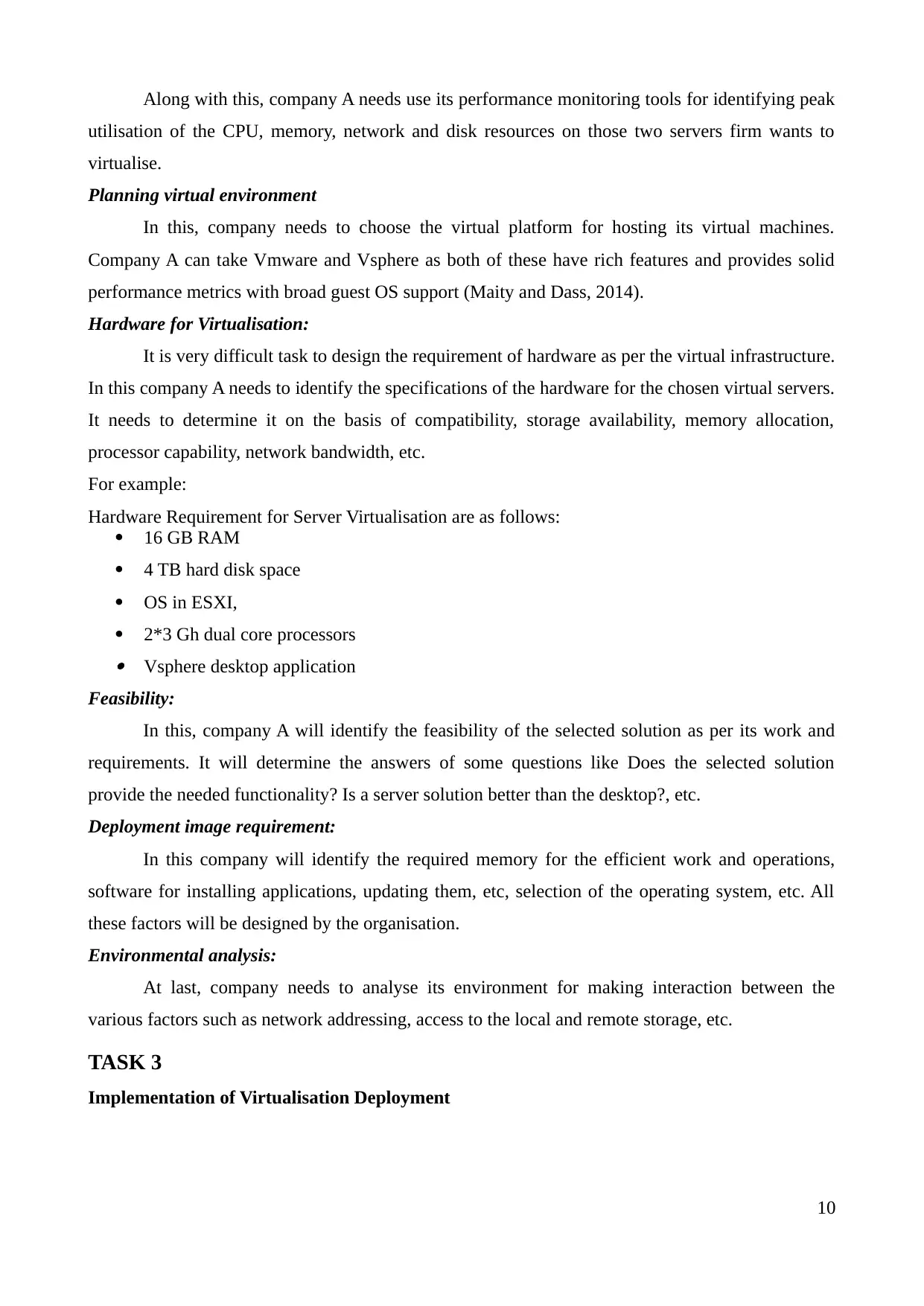
Along with this, company A needs use its performance monitoring tools for identifying peak
utilisation of the CPU, memory, network and disk resources on those two servers firm wants to
virtualise.
Planning virtual environment
In this, company needs to choose the virtual platform for hosting its virtual machines.
Company A can take Vmware and Vsphere as both of these have rich features and provides solid
performance metrics with broad guest OS support (Maity and Dass, 2014).
Hardware for Virtualisation:
It is very difficult task to design the requirement of hardware as per the virtual infrastructure.
In this company A needs to identify the specifications of the hardware for the chosen virtual servers.
It needs to determine it on the basis of compatibility, storage availability, memory allocation,
processor capability, network bandwidth, etc.
For example:
Hardware Requirement for Server Virtualisation are as follows:
16 GB RAM
4 TB hard disk space
OS in ESXI,
2*3 Gh dual core processors Vsphere desktop application
Feasibility:
In this, company A will identify the feasibility of the selected solution as per its work and
requirements. It will determine the answers of some questions like Does the selected solution
provide the needed functionality? Is a server solution better than the desktop?, etc.
Deployment image requirement:
In this company will identify the required memory for the efficient work and operations,
software for installing applications, updating them, etc, selection of the operating system, etc. All
these factors will be designed by the organisation.
Environmental analysis:
At last, company needs to analyse its environment for making interaction between the
various factors such as network addressing, access to the local and remote storage, etc.
TASK 3
Implementation of Virtualisation Deployment
10
utilisation of the CPU, memory, network and disk resources on those two servers firm wants to
virtualise.
Planning virtual environment
In this, company needs to choose the virtual platform for hosting its virtual machines.
Company A can take Vmware and Vsphere as both of these have rich features and provides solid
performance metrics with broad guest OS support (Maity and Dass, 2014).
Hardware for Virtualisation:
It is very difficult task to design the requirement of hardware as per the virtual infrastructure.
In this company A needs to identify the specifications of the hardware for the chosen virtual servers.
It needs to determine it on the basis of compatibility, storage availability, memory allocation,
processor capability, network bandwidth, etc.
For example:
Hardware Requirement for Server Virtualisation are as follows:
16 GB RAM
4 TB hard disk space
OS in ESXI,
2*3 Gh dual core processors Vsphere desktop application
Feasibility:
In this, company A will identify the feasibility of the selected solution as per its work and
requirements. It will determine the answers of some questions like Does the selected solution
provide the needed functionality? Is a server solution better than the desktop?, etc.
Deployment image requirement:
In this company will identify the required memory for the efficient work and operations,
software for installing applications, updating them, etc, selection of the operating system, etc. All
these factors will be designed by the organisation.
Environmental analysis:
At last, company needs to analyse its environment for making interaction between the
various factors such as network addressing, access to the local and remote storage, etc.
TASK 3
Implementation of Virtualisation Deployment
10
Paraphrase This Document
Need a fresh take? Get an instant paraphrase of this document with our AI Paraphraser

As per the given case, company A needs to create two virtual machines and network these
together. There need to have correct memory, CPU and storage resources. One server selected by
the company is VM Server whose specifications are as follows.
Processor: One virtual processor on a host with one or more logical processors. Along with it, a
multiprocessor host with the two CPUs
Chip Set:
Intel 440BX-based motherboard
NS338 SIO 82093AA IOAPIC
Memory: 3.6GB
Graphics: VGA and SVGA suuport
Floppy Drive: two 1.44MB floppy devices
Serial Ports: 4 serial ports and output serial ports.
Virtual Network:
Ethernet based protocols such as TCP/IP, Microsoft networking, Samba, Novell Netware,
etc.
It supports 9 or more virtual Ethernet switches.
For installing Vmware company needs to follow the following procedure
11 Start Vmware Workstation
11 Enter the serial number of the product which is on the registered card in the package (if its
first time to open Vmware station)
11 Start the New Virtual Machine Wizard
11 Use NEXT for navigating from the series of the screens
11 Select the method which company wants to configure the virtual machine
11
together. There need to have correct memory, CPU and storage resources. One server selected by
the company is VM Server whose specifications are as follows.
Processor: One virtual processor on a host with one or more logical processors. Along with it, a
multiprocessor host with the two CPUs
Chip Set:
Intel 440BX-based motherboard
NS338 SIO 82093AA IOAPIC
Memory: 3.6GB
Graphics: VGA and SVGA suuport
Floppy Drive: two 1.44MB floppy devices
Serial Ports: 4 serial ports and output serial ports.
Virtual Network:
Ethernet based protocols such as TCP/IP, Microsoft networking, Samba, Novell Netware,
etc.
It supports 9 or more virtual Ethernet switches.
For installing Vmware company needs to follow the following procedure
11 Start Vmware Workstation
11 Enter the serial number of the product which is on the registered card in the package (if its
first time to open Vmware station)
11 Start the New Virtual Machine Wizard
11 Use NEXT for navigating from the series of the screens
11 Select the method which company wants to configure the virtual machine
11
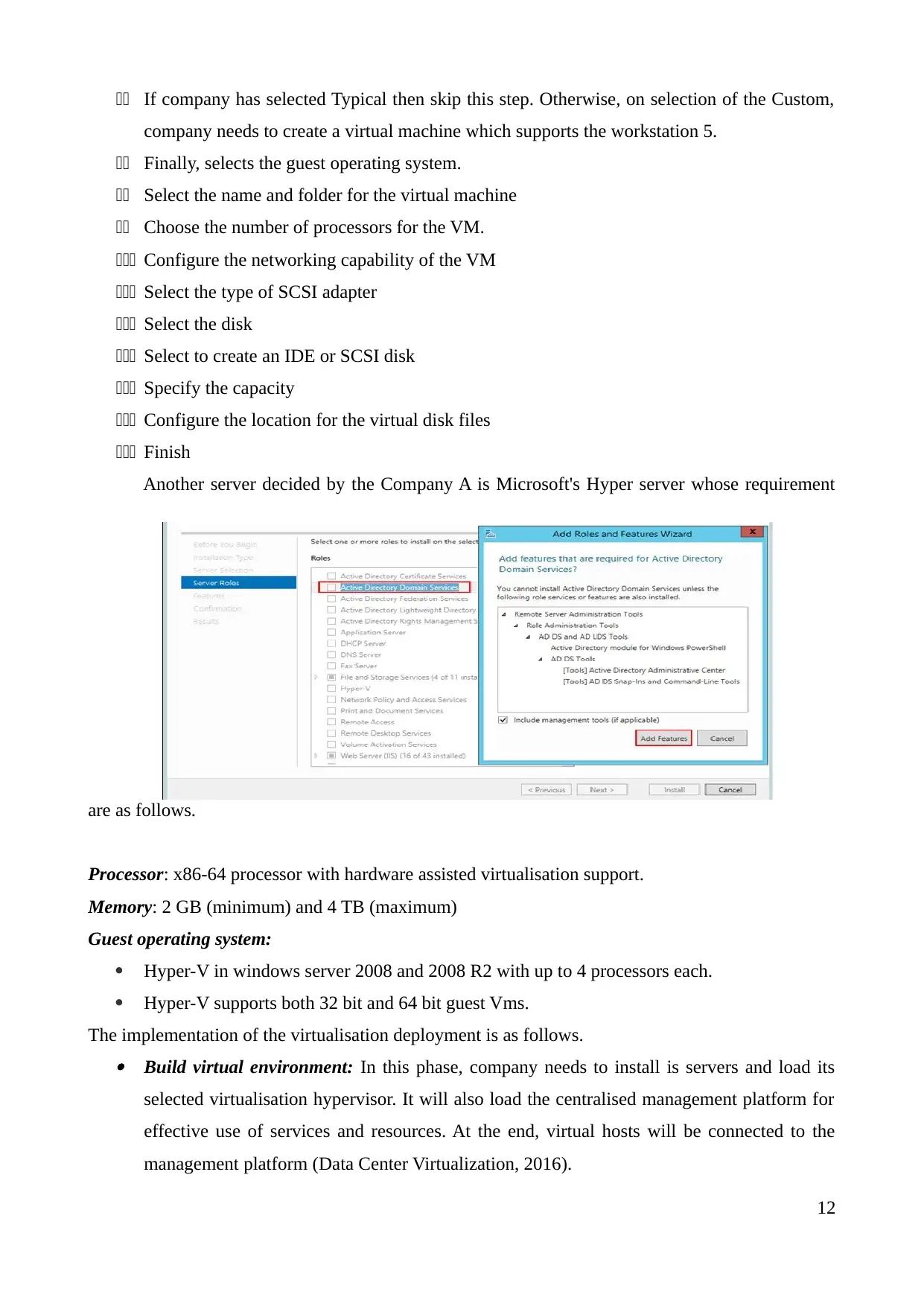
11 If company has selected Typical then skip this step. Otherwise, on selection of the Custom,
company needs to create a virtual machine which supports the workstation 5.
11 Finally, selects the guest operating system.
11 Select the name and folder for the virtual machine
11 Choose the number of processors for the VM.
111 Configure the networking capability of the VM
111 Select the type of SCSI adapter
111 Select the disk
111 Select to create an IDE or SCSI disk
111 Specify the capacity
111 Configure the location for the virtual disk files
111 Finish
Another server decided by the Company A is Microsoft's Hyper server whose requirement
are as follows.
Processor: x86-64 processor with hardware assisted virtualisation support.
Memory: 2 GB (minimum) and 4 TB (maximum)
Guest operating system:
Hyper-V in windows server 2008 and 2008 R2 with up to 4 processors each.
Hyper-V supports both 32 bit and 64 bit guest Vms.
The implementation of the virtualisation deployment is as follows. Build virtual environment: In this phase, company needs to install is servers and load its
selected virtualisation hypervisor. It will also load the centralised management platform for
effective use of services and resources. At the end, virtual hosts will be connected to the
management platform (Data Center Virtualization, 2016).
12
company needs to create a virtual machine which supports the workstation 5.
11 Finally, selects the guest operating system.
11 Select the name and folder for the virtual machine
11 Choose the number of processors for the VM.
111 Configure the networking capability of the VM
111 Select the type of SCSI adapter
111 Select the disk
111 Select to create an IDE or SCSI disk
111 Specify the capacity
111 Configure the location for the virtual disk files
111 Finish
Another server decided by the Company A is Microsoft's Hyper server whose requirement
are as follows.
Processor: x86-64 processor with hardware assisted virtualisation support.
Memory: 2 GB (minimum) and 4 TB (maximum)
Guest operating system:
Hyper-V in windows server 2008 and 2008 R2 with up to 4 processors each.
Hyper-V supports both 32 bit and 64 bit guest Vms.
The implementation of the virtualisation deployment is as follows. Build virtual environment: In this phase, company needs to install is servers and load its
selected virtualisation hypervisor. It will also load the centralised management platform for
effective use of services and resources. At the end, virtual hosts will be connected to the
management platform (Data Center Virtualization, 2016).
12
⊘ This is a preview!⊘
Do you want full access?
Subscribe today to unlock all pages.

Trusted by 1+ million students worldwide
1 out of 15
Related Documents
Your All-in-One AI-Powered Toolkit for Academic Success.
+13062052269
info@desklib.com
Available 24*7 on WhatsApp / Email
![[object Object]](/_next/static/media/star-bottom.7253800d.svg)
Unlock your academic potential
Copyright © 2020–2025 A2Z Services. All Rights Reserved. Developed and managed by ZUCOL.





